

Howard Gardner's Multiple Intelligences. Howard Gardner theorized that there are multiple intelligences, and that we all use one or two for the most effective learning.

Our culture teaches, tests, reinforces and rewards primarily two kinds of intelligence: verbal/linguistic and logical/mathematical. His theory proposes that there are at least eight other kinds of intelligence that are equally important. They are “languages” that most people speak, and that cut through cultural, educational, and ability differences. The Four Quadrant Model of the Brain. Ned Herrmann's Whole Brain Model Diagram from Models of the Brain - Theories of Brain Organisation by Charles Cave Ned Herrmann combined the Triune Brain model of Paul McLean with the Left/Right Brain hemisphere theory of Roger Sperry to form a model of the human brain with two paired structures, the two halves of the cerebral system and the two halves of the limbic system.

(the basal or Reptilian brain being not included in this model, or else include along with the Limbic). The Digigogy Collaborative - Home.
Bloom's Taxonomy of Learning Domains. Note: This site is moving to KnowledgeJump.com.
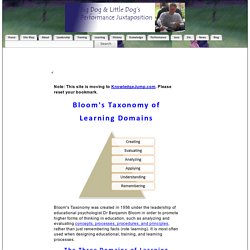
Please reset your bookmark. Bloom's Taxonomy was created in 1956 under the leadership of educational psychologist Dr Benjamin Bloom in order to promote higher forms of thinking in education, such as analyzing and evaluating concepts, processes, procedures, and principles, rather than just remembering facts (rote learning). Education 3.0 and the Pedagogy (Andragogy, Heutagogy) of Mobile Learning. The evolution of the web from Web 1.0 to Web 2.0 and now to Web 3.0 can be used a metaphor of how education should also be evolving, as a movement based on the evolution from Education 1.0 to Education 3.0.

I discussed this in Schools are doing Education 1.0; talking about doing Education 2.0; when they should be planning and implementing Education 3.0. Many educators are doing Education 1.0; talking about doing Education 2.0; when they should be planning and implementing Education 3.0. This post compares the developments of the Internet-Web to those of education. The Internet has become an integral thread of the tapestries of most societies throughout the globe.
Millennial Characturistics.pdf. Sep05_article03. Editor’s Note: Instructional design provides many techniques to assist learning.

Brain-Based Learning looks at research on neural mechanisms that facilitate the learning process. as a way to optimize performance. Some approaches are already used under other names; others provide leverage to optimize learning. Stephanie A. Clemons Abstract As higher education institutions push for more online courses instructors are faced with issues and challenges related to teaching in the online learning environment. Teaching with Technology: Tools and Strategies to Improve Student Learning. Tools of Engagement for Face-to-Face, Blended and Online Teaching That’s why we created this special report.
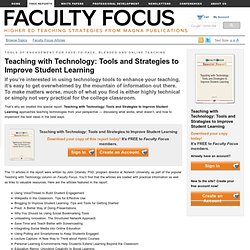
Teaching with Technology: Tools and Strategies to Improve Student Learning approaches teaching technologies from your perspective — discussing what works, what doesn’t, and how to implement the best ideas in the best ways. Teaching with Technology: Tools and Strategies to Improve Student Learning. The Flipped Classroom: Turning the Traditional Classroom on its Head. Cognitive Theory. Jean Piaget (1896 - 1980) was employed at the Binet Institute in the 1920s, where his job was to develop French versions of questions on English intelligence tests.
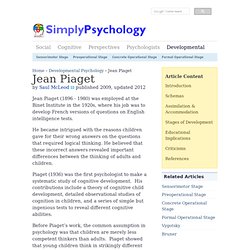
He became intrigued with the reasons children gave for their wrong answers on the questions that required logical thinking. Vygotsky. The work of Lev Vygotsky (1934) has become the foundation of much research and theory in cognitive development over the past several decades, particularly of what has become known as Social Development Theory.
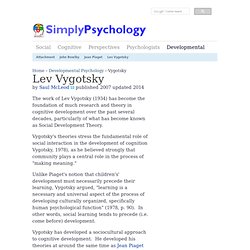
Vygotsky's theories stress the fundamental role of social interaction in the development of cognition Vygotsky, 1978), as he believed strongly that community plays a central role in the process of "making meaning. " Bruner - Learning Theory in Education. By Saul McLeod published 2008,updated The outcome of cognitive development is thinking.
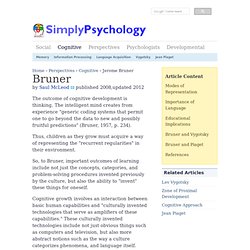
The intelligent mind creates from experience "generic coding systems that permit one to go beyond the data to new and possibly fruitful predictions" (Bruner, 1957, p. 234). Thus, children as they grow must acquire a way of representing the "recurrent regularities" in their environment. So, to Bruner, important outcomes of learning include not just the concepts, categories, and problem-solving procedures invented previously by the culture, but also the ability to "invent" these things for oneself.
Cognitive growth involves an interaction between basic human capabilities and "culturally invented technologies that serve as amplifiers of these capabilities. " Conditions of Learning - Gagne. This theory stipulates that there are several different types or levels of learning.
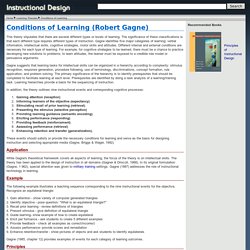
The significance of these classifications is that each different type requires different types of instruction. Gagne identifies five major categories of learning: verbal information, intellectual skills, cognitive strategies, motor skills and attitudes. Different internal and external conditions are necessary for each type of learning. For example, for cognitive strategies to be learned, there must be a chance to practice developing new solutions to problems; to learn attitudes, the learner must be exposed to a credible role model or persuasive arguments. Gagne suggests that learning tasks for intellectual skills can be organized in a hierarchy according to complexity: stimulus recognition, response generation, procedure following, use of terminology, discriminations, concept formation, rule application, and problem solving. Application. Jerome Bruner.
Biography[edit] Jerome Bruner was born on October 1, 1915 in New York, to Heman and Rose Bruner, who emigrated from Poland.[2] He received a bachelor's degree in psychology, in 1937 from Duke University. Bruner went on to earn a master's degree in psychology in 1939 and then a doctorate in psychology in 1941 from Harvard University. In 1939, Bruner published his first psychological article studying the effect of thymus extract on the sexual behavior of the female rat.[3] During World War II, Bruner served on the Psychological Warfare Division of the Supreme Headquarters of the Allied Expeditory Force Europe committee under Eisenhower, researching social psychological phenomena.[2] In 1945, Bruner returned to Harvard as a psychology professor and was heavily involved in research relating to cognitive psychology and educational psychology.
In 1970, Bruner left Harvard to teach at the University of Oxford in England. Professional Development with Alan November. What We Learn When We Learn by Doing. Schank, Roger C. (1995) What We Learn When We Learn by Doing. (Technical Report No. 60). Northwestern University, Institute for Learning Sciences. Roger C. Schank Institute for the Learning SciencesNorthwestern University. Index of Learning Styles Questionnaire.
Vark Learning Styles Questionnaire. How to Plan Instruction Using the Video Game Model. A Neurologist Makes the Case for Teaching Teachers About the Brain. "Neuroscience should be required for all students [of education] . . . to familiarize them with the orienting concepts [of] the field, the culture of scientific inquiry, and the special demands of what qualifies as scientifically based education research. " - Eisenhart & DeHaan, 2005 Do you recall some of your college professors who knew their subject matter but had zero teaching skills? Mindset (book) Carol S. Dweck (born October 17, 1946) is the Lewis and Virginia Eaton Professor of Psychology at Stanford University.[1] She graduated from Barnard College in 1967 and earned a Ph.D. from Yale University in 1972.
She taught at Columbia University, Harvard University, and the University of Illinois before joining the Stanford faculty in 2004. Contributions[edit] Professor Dweck has primary research interests in motivation,[2][3][4][5][6][7] personality, and development. Carol Dweck.